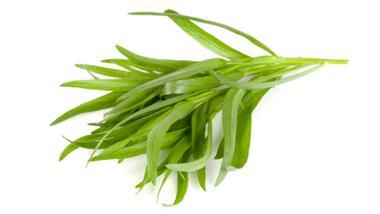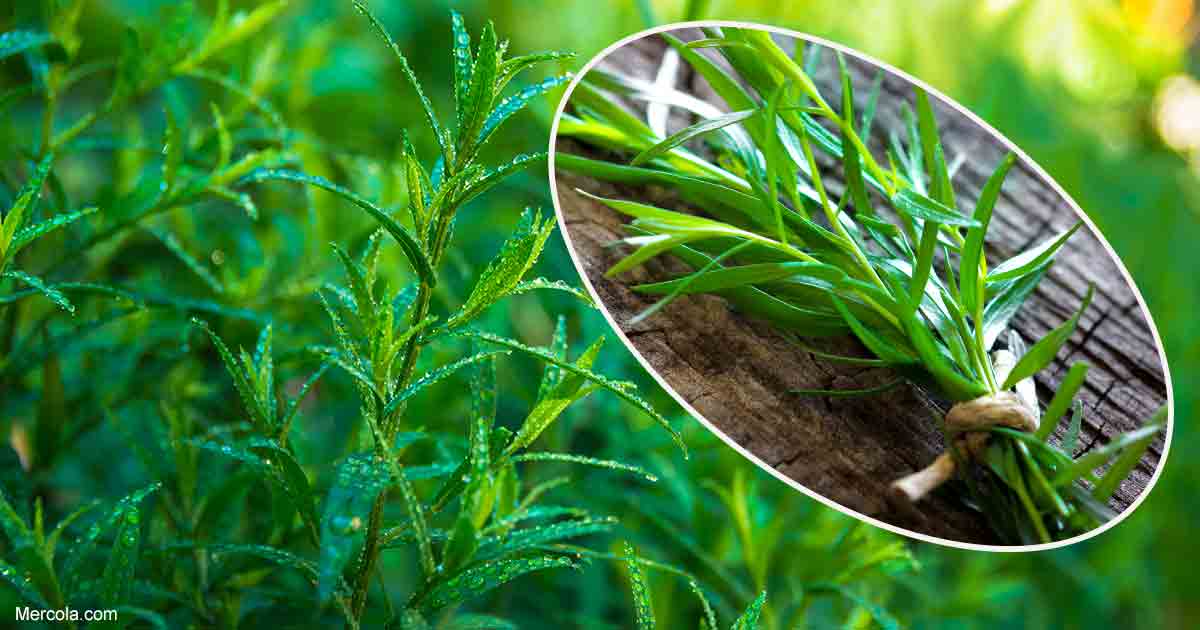Tarragon Adds a French Twist to Your Meals

Story at-a-glance
- Tarragon is a staple ingredient in French cuisine, and is one of the “Fines Herbes” — the most widely used herbs in French cooking
- Tarragon contains various nutrients and essential oils that can provide various benefits
Tarragon (pronounced TEHR-uh-gon) or Artemisia dracunculus is an herb that is popular in the world of cooking. In fact, tarragon is such a vital part of French cuisine that it is one of the “Fines Herbes.”
These are the four most commonly used herbs in French cuisine, which also includes parsley, chervil and chives.1 Tarragon is known for its slightly bittersweet flavor, with an aroma similar to anise.2
The earliest records of tarragon date back to more than 600 years ago. It was believed to have been introduced to Italy in the 10th century during the time of the Mongol invasions. The Mongolians used tarragon as a sleep aid, breath freshener and seasoning.
After this turbulent period, some tarragon histories have St. Catherine of Siena bringing tarragon back to France after a visit with Pope Clement VI.3 However, she could not have done this as she was only 5 years old when Clement VI4 died. While other histories have tarragon arriving in France in the 1500s, if St. Catherine was the one who brought it to France, most likely it was after her visit to see Pope Gregory VI in 1376.5
The Different Health Benefits of Tarragon
Tarragon contains various nutrients and essential oils that can provide a multitude of benefits. The most well-known ones include:
• Pain Relief — Chewing the leaves can help relieve pain, especially in the mouth or tooth. You can consume tarragon tea to get the same benefit.
• Induce Sleep — Drinking tarragon tea can help those with insomnia. The calming effect of the herb’s compounds can help you rest well at night.
• Increase Appetite — If you’re having trouble getting your appetite up, try consuming tarragon. It’s been reported to have stimulating properties for your stomach.
• Promote Reproductive Health in Females — Tarragon can help maintain a healthy female reproductive tract, and may also help women deal with suppressed menstruation.
• Improve Intestinal Function — Tarragon is a vermifuge, meaning it can help expel parasitic worms from the intestines. As a result, this lowers your risk of developing intestinal ailments and malabsorption.
• Cardiovascular Health — Your heart and arteries can benefit from tarragon greatly, because it acts as an inhibitor of platelet aggregation. As a result, the risk of developing a heart attack or a stroke is potentially lower.
The Different Uses of Tarragon
Tarragon is versatile and can be used in various types of dishes, such as:6
• Potatoes — Spice up a potato salad by sprinkling tarragon over it.
• Eggs — Add new layers of flavor to classic egg dishes such as deviled eggs.
• Seafood — Bring out a wonderful aroma to various fish such as salmon and tuna using tarragon. You can also sprinkle it on clams and scallops.
• Poultry — Give your roasted chicken a flavor boost by covering it with tarragon before cooking.
• Sauces — Tarragon can make your sauces taste better. You can add it to sour cream, lemon sauce, pesto and other sauces.
How to Grow Tarragon in Your Own Home
Growing your own herbs is a convenient way of having fresh ingredients ready whenever you need to use them for cooking. Aside from that, you have the benefit of avoiding pesticides and other chemicals that may have been used in commercially grown herbs.
In the case of tarragon, planting it should start indoors with a small pot. The soil should be fertile, well-draining and should have a pH level between 6.5 and 7.5.
Once these requirements are met, plant four to six seeds around April, or before your area’s last expected frost. Place the pot in a room location that has low light and at room temperature.7,8
When it comes to watering the plant, do it regularly, using only an average amount of water. You must allow the soil to go almost dry before watering again, or else the seedlings will suffer. After 10 to 14 days of regular watering, the seeds will start to grow. Then, transfer the pot outdoors where it can receive full sunlight.9,10
Once the seedlings reach around 2 inches in height, start thinning them down to one plant. Choose only the healthiest or strongest looking seedling. In about seven weeks, the plant will be ready for harvesting. A good indicator for harvesting is when the plant reaches a height between 12 and 36 inches.11,12
Growing Tarragon Completely Indoors
If circumstances won’t allow you to grow tarragon outdoors, you can grow it inside the house using plant-growing lights. You can use standard fluorescent lamps, but a high-output T5 fluorescent or high-intensity discharge (HID) lamp will produce higher-quality leaves. Regarding the position of the lamp, a standard fluorescent or HID lamp should be 2 to 4 inches above the plant. But if you’re using a T5 lamp, place it 1 foot above the plant.13
Harvesting and Storing Tarragon
There’s no specific time to harvest tarragon. Once your plant reaches a height between 12 and 36 inches, it’s ready for harvesting. Use kitchen shears when picking off the leaves because they are very delicate.
If you use your hands, you risk releasing the aromatic oils inside the leaves. Once you have gathered enough, wash them with cool water and gently pat them dry.14
Storing tarragon is easy. Simply wrap a bunch of leaves in a damp paper towel and place it inside the refrigerator. You can also place the leaves inside a plastic bag or in a jar filled with water that’s lightly covered with plastic. It’s important that the leaves are not dried, because they will lose their flavor and nutrients.15
Cooking With Tarragon: Creamy Tarragon Chicken
Poultry pairs well with tarragon and any dish that combines these two is guaranteed to be a hit. In this recipe, you’ll learn how to make a creamy tarragon sauce that goes very well with chicken. It’s something that you and your family will enjoy.16
Creamy Tarragon Chicken
Ingredients:
• 4 boneless and skinless pasture-raised chicken breasts
• 1/4 teaspoon of Himalayan salt, plus more to taste
• 1/4 teaspoon of freshly ground pepper, plus more to taste
• 3 teaspoon of coconut oil
• 1/4 cup of finely chopped shallots
• 1 tablespoon of Dijon mustard
• 1 tablespoon of homemade sour cream
• 1 tablespoon of chopped fresh tarragon
Procedure:
1. Season the chickens on both sides with 1/4 teaspoon each of salt and pepper. Heat 1 1/2 teaspoons of coconut oil in a large heavy skillet over medium-high heat. Add the chickens and cook until well browned, about 3 minutes per side. Transfer to a plate and tent with foil.
2. Reduce the heat to medium. Add the remaining 1 1/2 teaspoons of oil to the pan. Add shallots; cook, stirring, until softened in about 2 to 3 minutes. Add broth and bring to a simmer. Cook until juices are reduced by half, for about 3 minutes.
3. Return the chicken and any accumulated juices to the pan; reduce heat to low. Simmer until the chicken is cooked through, about 4 minutes. Transfer the chicken to a warmed platter. Stir mustard, sour cream and tarragon into sauce. Season to taste with salt and pepper and spoon over the chicken.
Tarragon Can Also Be Used as an Essential Oil
Aside from its culinary uses, tarragon can also be made into an essential oil with aromatherapeutic properties. It has a wide variety of benefits, which include:17
• Deodorizer — Tarragon essential oil has effective antimicrobial properties. When diluted and applied on your underarms, it can help prevent the development of bad odor.
• Antirheumatic — Tarragon oil can help improve the flow of blood throughout the body and eliminate a toxin called uric acid. With these two benefits working together, the risks of developing rheumatism and arthritis are reduced.
• Circulatory — Improved blood flow throughout your body is one of the circulatory benefits of tarragon. It helps improve the distribution of oxygen, various nutrients and antioxidants in your body to keep your health in optimal condition.
• Stimulant — Tarragon essential oil has a stimulating effect on your brain, nervous, digestive and endocrinal systems, which helps support growth and improve your immune system.
Making tarragon essential oil is a simple process. The leaves are harvested, distilled and then packaged for use. The resulting oil is usually colorless, but in some cases it may have a slight green color. The aroma is reminiscent of anise or fennel, and has a slightly spicy taste. There are a few methods in which you can use the oil:
• Massage — Mix 3 to 4 drops of tarragon essential oil with a carrier oil, and then massage the mixture to your body to receive its therapeutic benefits.
• Bathwater — Add tarragon essential oil to your bathwater and soak in it so your body can feel refreshed afterwards.
• Hot compress — Add tarragon essential oil to your hot compress or use it as a tummy rub to help kill intestinal worms.
• Toothache reliever — Mix 1 or 2 drops of tarragon essential oil in a cup of warm water, then gargle the mixture to help alleviate toothaches.
Before using tarragon essential oil, you must be aware of its potential side effects. It contains estragole, also known as methyl chavicol, which can be poisonous in high doses.
Children and pregnant women should avoid using tarragon oil for safety reasons. Nevertheless, in controlled doses, the benefits can typically be enjoyed without any serious complications. Just consult with your doctor first before using the oil for proper guidance. 18 After you’ve been permitted to use the oil, do a skin patch test on your arm. Simply place a diluted drop on your skin to check for any irritations or allergic reactions. Should any side effects occur, stop using the oil immediately.
Sources and References
- 1 About Food, “Fines Herbes”
- 2 Spice Advice, “Tarragon”
- 3 Our Herb Garden, “Tarragon”
- 4 Encyclopaedia Britannica, “Clement VI”
- 5 Kenneth Randolph Taylor, Sundry Thoughts: Saints, Science Fiction and Other Topics, “St. Catherine of Siena”
- 6, 15 Food52, “Fresh Tarragon and Its 5 Best Uses” April 11, 2015
- 7, 9, 11, 13 HerbGardening.com, “How to Grow Tarragon”
- 8, 10, 12 Gardening Know How, “Growing Tarragon in the Herb Garden”
- 14 Gardening Know How, “Tarragon Plant Harvesting: Tips on Harvesting Tarragon Herbs”
- 16 EatingWell.com, “Tarragon Chicken”
- 17 Organic Facts, “Health Benefits of Tarragon Essential Oil”
- 18 Organic Facts, October 29, 2017

